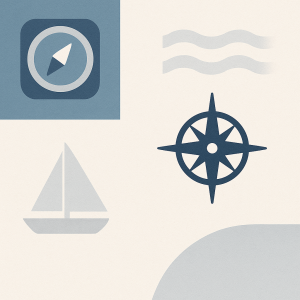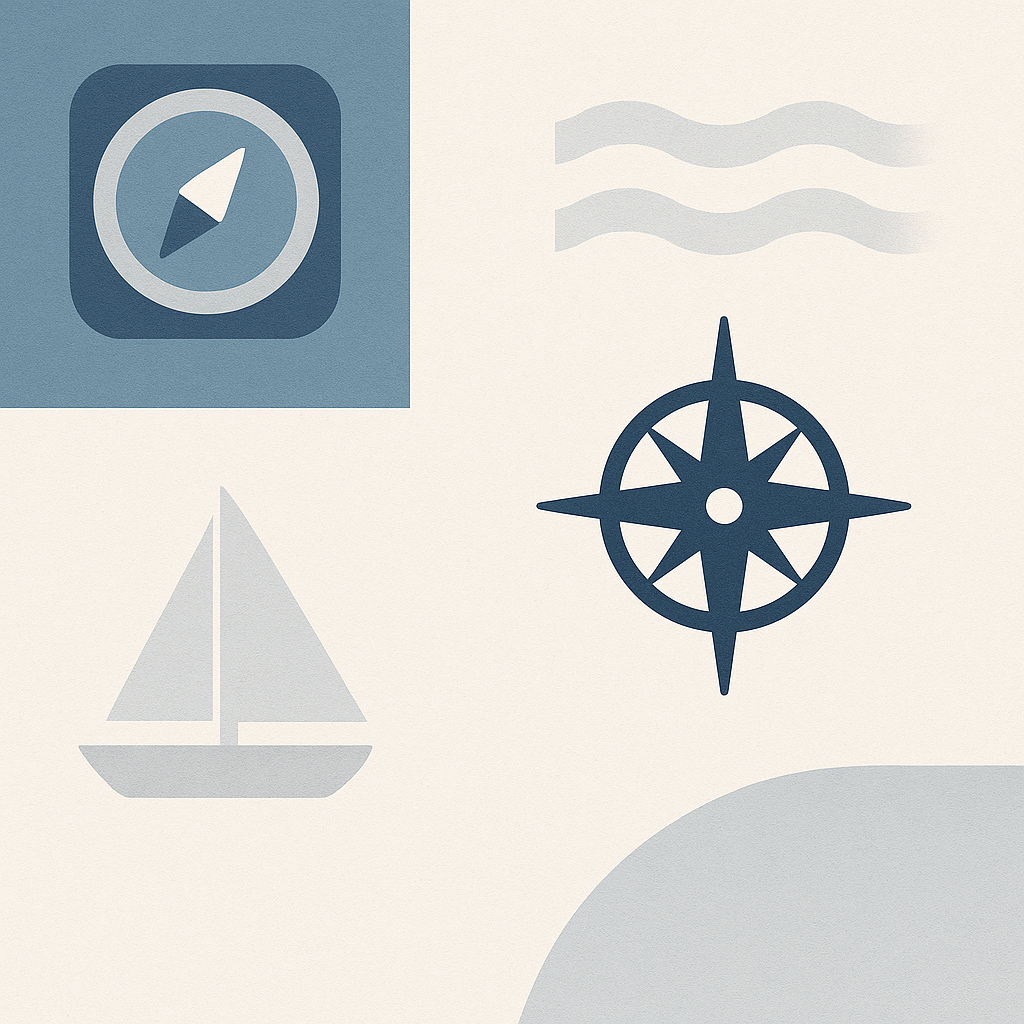Explore the evolving world of maritime navigation—from traditional celestial methods to cutting-edge ECDIS and satellite systems. Learn how tools, rules, and technologies ensure safe and efficient voyages at sea.
Why Maritime Navigation Matters in Modern Shipping
 In the vast blue wilderness of the ocean, where there are no road signs or traffic lights, navigation is everything. Whether it’s a container vessel approaching the Port of Singapore, a cruise liner sailing through the Caribbean, or a fishing boat in the North Atlantic, all rely on precise navigation to stay safe, compliant, and efficient.
In the vast blue wilderness of the ocean, where there are no road signs or traffic lights, navigation is everything. Whether it’s a container vessel approaching the Port of Singapore, a cruise liner sailing through the Caribbean, or a fishing boat in the North Atlantic, all rely on precise navigation to stay safe, compliant, and efficient.
Maritime navigation isn’t just about steering a ship from A to B. It’s a blend of tradition, science, and cutting-edge technology. From the time of astrolabes and sextants to today’s satellite-enabled ECDIS (Electronic Chart Display and Information System), maritime navigation has evolved to meet the growing complexities of global trade and environmental compliance.
According to the International Maritime Organization (IMO), over 90% of global trade moves by sea, involving millions of voyages every year. Navigating these ships safely across congested sea lanes, polar routes, and environmentally sensitive areas is a responsibility that spans mariners, port authorities, and global regulators alike.
From Stars to Satellites: A Brief History of Maritime Navigation
Maritime navigation has ancient roots. Early seafarers used stars, ocean swells, and birds to find land. The Polynesians famously navigated vast Pacific distances using natural cues and oral knowledge. By the 18th century, tools like the sextant and John Harrison’s marine chronometer revolutionized long-distance sailing, enabling accurate determination of longitude.
In modern navigation, GPS satellites, radar overlays, and real-time AIS (Automatic Identification System) updates have replaced guesswork with precision. Yet, the legacy of traditional methods remains embedded in seamanship education.
🔭 Today, maritime academies worldwide still teach celestial navigation as a backup skill, following IMO Model Courses and STCW (Standards of Training, Certification and Watchkeeping for Seafarers) guidelines.
Core Tools and Technologies in Maritime Navigation
Navigational Equipment and Bridge Tools
-
Magnetic Compass: The oldest tool still in use, often as a backup to electronic systems.
-
Gyrocompass: Uses the Earth’s rotation to provide true north—unaffected by magnetic interference.
-
Radar: Helps detect nearby ships, coastlines, and hazards—essential in poor visibility.
-
Echo Sounder: Measures water depth, crucial in shallow ports or while anchoring.
-
Automatic Identification System (AIS): Transmits ship data (position, speed, type) to nearby vessels and shore stations.
-
Voyage Data Recorder (VDR): The maritime equivalent of a black box, storing navigation and communication data.
-
ARPA (Automatic Radar Plotting Aid): Calculates the movement of nearby vessels to help avoid collisions.
These tools are often integrated on a ship’s Integrated Bridge System (IBS), improving situational awareness and reducing human error.
Electronic Navigation Systems
Electronic Chart Display and Information System (ECDIS)
ECDIS has become the industry standard for modern navigation. It digitally displays nautical charts, integrates GPS, radar, AIS, and weather overlays, and alerts officers to navigational dangers. Since July 2018, ECDIS has been mandatory on most SOLAS-regulated ships, per IMO carriage requirements.
Global Navigation Satellite Systems (GNSS)
Most ships use GPS (United States), but other systems like GLONASS (Russia), Galileo (EU), and BeiDou (China) provide global redundancy. Differential GNSS (DGNSS) improves accuracy further by correcting satellite errors with shore-based data.
Inertial Navigation Systems (INS)
Used in military and offshore operations, INS determines position based on acceleration and orientation without external references—vital in GPS-denied environments.
Navigation Methods: From Bearings to Route Planning
Dead Reckoning
The most basic method. A ship estimates its position based on course, speed, time, and last known position. While quick, it accumulates errors over time and requires correction via celestial or GPS fixes.
Celestial Navigation
Using sextants and celestial bodies (sun, stars, planets), mariners plot their position on paper charts. This traditional method still forms part of officer training and is considered a reliable backup.
Coastal Navigation
Near land, mariners rely on visual landmarks, buoys, and lighthouses. This method is common for ferries, tugs, and inland vessels.
Radar Fixing and Ranging
Radar ranges are compared against charted objects (e.g., lighthouses) to fix position. Especially useful in fog or at night.
Satellite Navigation
With GNSS, a ship’s position is known to within a few meters—ideal for ocean passage planning, dynamic positioning systems, and ECDIS overlays.
Passage Planning
This is the strategic method of plotting an entire voyage—from berth to berth. The STCW Code and SOLAS Chapter V Regulation 34 mandate that all voyages be planned and executed according to recognized guidelines.
Route planning includes:
-
Safe water depths (under keel clearance)
-
Traffic separation schemes
-
Environmental restrictions (e.g., no-go areas under MARPOL)
-
Availability of pilotage and port services
Navigational Rules and Global Standards
COLREGs: International Regulations for Preventing Collisions at Sea
Developed by IMO, the COLREGs outline the “rules of the road” at sea. They guide everything from overtaking procedures to night-time lighting. All seafarers must be proficient in them—knowledge that can mean the difference between safety and disaster.
Notable parts:
-
Rule 5: Proper lookout by sight and hearing
-
Rule 6: Safe speed
-
Rule 7: Risk of collision
-
Rule 8: Action to avoid collision
-
Rule 10: Traffic separation schemes
📚 Recommended Reading: The American Practical Navigator (Bowditch), a navigation bible endorsed by the U.S. Navy and maritime academies globally.
SOLAS and STCW Compliance
The Safety of Life at Sea (SOLAS) convention governs navigational equipment carriage requirements, while the STCW Code ensures crew competency in navigation, route planning, and emergency procedures.
According to the Paris MoU Annual Report 2023, “navigational safety” remains one of the most common areas of deficiency found during inspections, especially among small cargo and fishing vessels.
Real-World Application: Navigation Near High-Traffic Areas
Let’s consider the English Channel, one of the world’s busiest waterways, with over 500 vessels crossing daily. Ships must navigate:
-
Dense traffic lanes
-
Strong tides and weather changes
-
Frequent ferry crossings
Here, bridge teams rely heavily on AIS, radar overlays, and ECDIS, combined with lookouts and visual bearings. Any mistake can lead to collisions or groundings, such as the MV Tricolor incident in 2002.
Port approaches, like those into Rotterdam or Shanghai, require precision navigation. Ships often switch to pilotage mode, handing control to local pilots familiar with port layout, tides, and berths.
Challenges in Modern Maritime Navigation
Electronic Overload
While automation helps, it can also distract. Over-reliance on GPS or ECDIS without visual confirmation can be dangerous—a risk highlighted in the MAIB’s 2022 accident report on the MV Kaami, which grounded due to improper ECDIS use.
Cybersecurity Threats
As navigation systems become connected, they’re also exposed. In 2021, several global shipping companies reported GPS spoofing near Chinese ports. Cyber resilience is now part of IMO’s ISM Code amendments (Resolution MSC.428(98)).
Training Gaps
Digital systems evolve fast, but seafarer training often lags behind. According to Lloyd’s Register’s Human Element Report 2023, 47% of officers surveyed said they lacked sufficient ECDIS training on new models.
Future Outlook: Smart Navigation and Autonomous Shipping
The future of maritime navigation will be increasingly autonomous, data-driven, and green. Here’s what’s emerging:
-
AI-powered route optimization: Platforms like Wärtsilä’s Navi-Port recommend routes that save fuel and avoid weather hazards.
-
e-Navigation: A global IMO strategy promoting harmonized digital systems, including e-pilotage, e-positioning, and real-time updates.
-
Remote bridge operations: Companies like Kongsberg are testing shore-based control for ferries and coastal cargo ships.
-
Dynamic Positioning (DP) systems: Becoming standard in offshore operations, allowing pinpoint movement without anchoring.
🌍 In 2023, the IMO adopted guidelines for MASS (Maritime Autonomous Surface Ships), setting the legal groundwork for future navigation without humans onboard.
Frequently Asked Questions (FAQs)
What is the most reliable navigation method today?
GPS is the most accurate, but redundancy with radar, visual bearings, and celestial navigation is essential for safety.
Why is ECDIS important?
ECDIS integrates multiple systems (charts, GPS, radar, AIS) into one interface, improving accuracy and decision-making. It’s also mandatory for most ships under SOLAS.
Are traditional methods like celestial navigation still taught?
Yes. It’s part of STCW requirements and serves as a crucial backup in case of GPS or power failure.
How often do ships update their charts?
Digital charts (ENCs) are updated weekly or in real-time. Ships must carry the latest version as per IMO and Flag State requirements.
What is a Pilot on a ship?
A maritime pilot is a licensed professional who boards ships near port entrances to guide them safely through local waters. Pilots work closely with bridge officers but do not take full legal responsibility.
Can ships navigate without GPS?
Yes, but with limitations. Alternative methods like radar fixes, celestial navigation, and dead reckoning are less accurate and require more skill.
Conclusion
Maritime navigation sits at the heart of seafaring—past, present, and future. From ancient voyagers who read stars to modern officers managing multi-million-dollar bridges, navigation is a discipline that marries tradition with innovation.
The tools have changed, but the mission remains the same: to move safely and efficiently across oceans. As shipping enters a new era of autonomy and sustainability, navigational systems will become even more advanced—yet the mariner’s judgment, situational awareness, and training will always remain vital.
Whether you’re a deck cadet, captain, or curious enthusiast, understanding the fundamentals and future of navigation will keep you aligned with the compass of safe seamanship.
References
-
International Maritime Organization (IMO). (2023). https://www.imo.org
-
STCW Convention and Code. (2022). https://www.imo.org/en/OurWork/HumanElement/Pages/STCW-Convention.aspx
-
SOLAS Convention. (2023). https://www.imo.org/en/About/Conventions/Pages/International-Convention-for-the-Safety-of-Life-at-Sea-(SOLAS),-1974.aspx
-
Lloyd’s Register Human Element Report. (2023). https://www.lr.org
-
MAIB Accident Reports. (2022). https://www.gov.uk/government/organisations/marine-accident-investigation-branch
-
Paris MoU Annual Report. (2023). https://www.parismou.org
-
The Nautical Institute. (2024). https://www.nautinst.org
-
DNV Maritime Forecast 2050. (2024). https://www.dnv.com/publications
-
Wärtsilä Navi-Port Platform. https://www.wartsila.com/marine/products/navigation/navi-port
-
Bowditch, N. The American Practical Navigator. (U.S. Govt. Printing Office)


Do you have any video of that? I’d care to find out
some additional information.